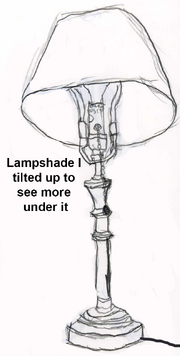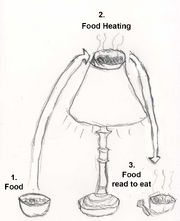
Drawing of lamp
Artifact analysis is pretty much exactly what it sounds like, it is analyzing an artifact in many different ways to see why and how it is made and used.
This is good for improving already made objects or finding new ways to use them, as well understanding the culture the artifact is in better.
The nature of this method is analysis and research, since you are researching into a object by analyzing it. I think a context in using this method is figuring out more about an object so you can improve it, use it in a different way, or replace it with something else.
Description of the Method[]
Basic description
"A systematic examination of the material, aesthetic, and interactive qualities of objects contributes to an understanding of their physical, social, and cultural contexts"- Martin and Hanington, Universal Methods of design
Artifact Analysis is all about understand an object, in as many different ways as possible. This means looking at its:
- Material: What is it made up of, is it human made? Why is it made with that? The material section should cover all parts of the object as well, so if its made up a lot of different parts, its good to have all the parts mentioned here.
- Construction: Who made it, how did they make it, why did they make it this way, where was it made? Was it made to look a certain way, or match a certain style? Is there evidence of the process of making it still on it?
- Function: What was the intended use of the product? Is there multiple different functions to it, or hidden functions to it?(for instance, in my project the lamp was not only made to function as a lamp, but as a decoration as well.)
- Province: What was this objects history? Where was it made, who produced it, what was its journey after being made? How did it end up were it currently is? How did it end up being used, both currently and in the past places its been?
- Value: What values does it have to different people? Why did the person who made it value it? What values does it have for the person currently having it? How does society as a whole value it? Does it have social or cultural values to it, if so what?
All of these help you get a better feel for why a person has an object, and why it exists in the first place. After you learn all about the object and how it effects everyday life, you can use that information to make that object better at what it does, replace that object with something else, or even make that object do something completely different then what it was supposed to do.
Actually Doing the method
The first thing you should do after picking an object to analyze is draw it out. This allows you to become more attached to the object, as well as give you time to really analyze the physical shape and all the little pieces that make up that artifact.
After your done drawing the artifact, start picking it up, moving it around, finding out as much about the object as you can from just looking at it. The goal is to find out the five dimensions I mentioned earlier.
After you have found out as much as you can about the object by itself, I recommend doing some research on the object, finding out more about it that you can't find out by just looking at it. You could interview people that have used the object a lot, or do research online about that object or objects like it. The point gain as much knowledge about the object as possible, so you can gain more insights.
Positives and negatives[]
Positives
- You get to know about an object very well, and why it exists.
- You can learn how people interact with that object and why
- Gets you to think about things from a whole new angle, not the interaction, but the object being interacted with
Negatives
- Its sometimes hard to find information on some objects. Is easy to find dead ends with your research on them
- Some objects are very complicated, with many different uses.
- May be hard to choose what object you want to analyze
Tips and Tricks[]
- Draw out the object from multiple angles, to get a better feel of it
- Look online and talk to people to find more information on it.
- Try to gain as much information from the object as you can, sometimes you can find little hints about where it was made and what happened to it.
- Make sure you cover all the different aspects of it, as in the parts of the object and all the functions it might have.
Project we used it for[]

One of my designs I made, it heats food using the light bulb in the lamp
For this project, we were giving a list of objects to choose from, and I ended up going with lamp after way to long of a deliberation(like I settled on one and then changed my mind over three different times). I ended up going with a lamp because I feel like there is a lot you can do to it, because it has so many parts to it. Speaking to that, doing a lamp was kind of annoying because of that as well, and ended up having to divide up the materials part to three different sections, Top, Middle, and Bottom of the lamp, and talked in detail about each of them, which ended up being way more then I expected.
I also had trouble finding information on it, and had to do some detective work to find it. I quickly saw it was pottery barn from the bottom, but had no clue where it was made, and what model it was. Through searching online, I found lamps that looked like them in pottery barn, and ended up basing it of those, but never could find the exact lamp.
Making the concepts was also fun, they made you think outside the box and I liked some of the things I came up with through this.
Hughes's Corner[]
This was surprisingly a fun one, I do not known if I will ever use this one again, like as in if I would get a chance to do it again. I liked drawing it out, and while I didnt find out out the exact information about the lamp, it was fun researching on it, trying to go off any leads I can find to get more information on it.